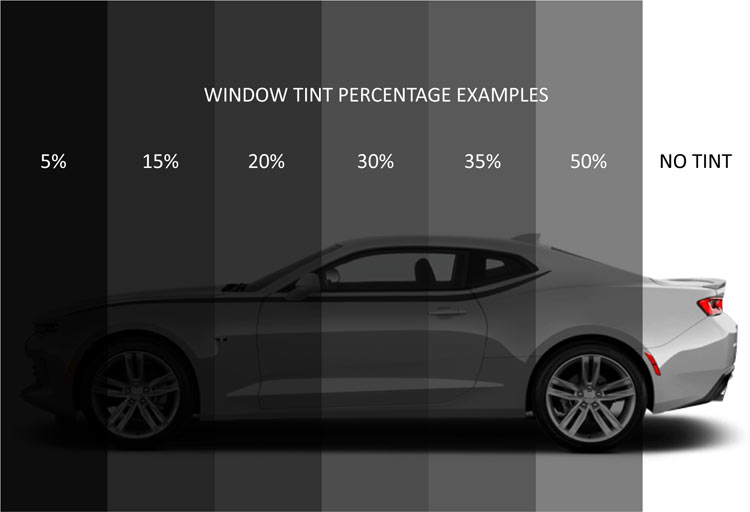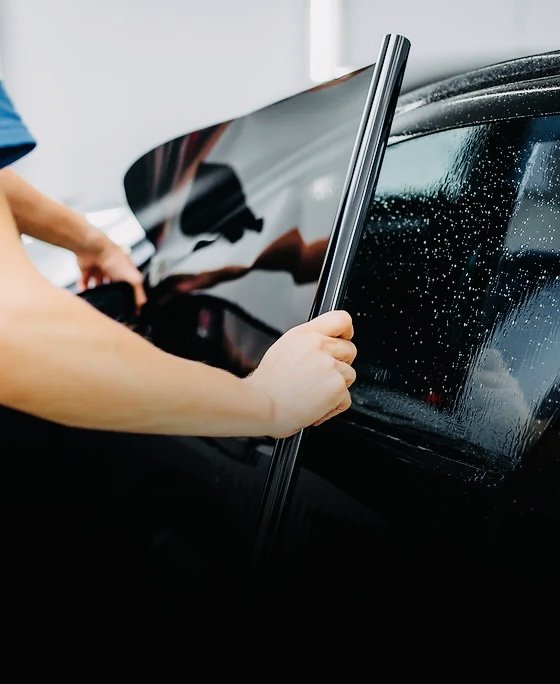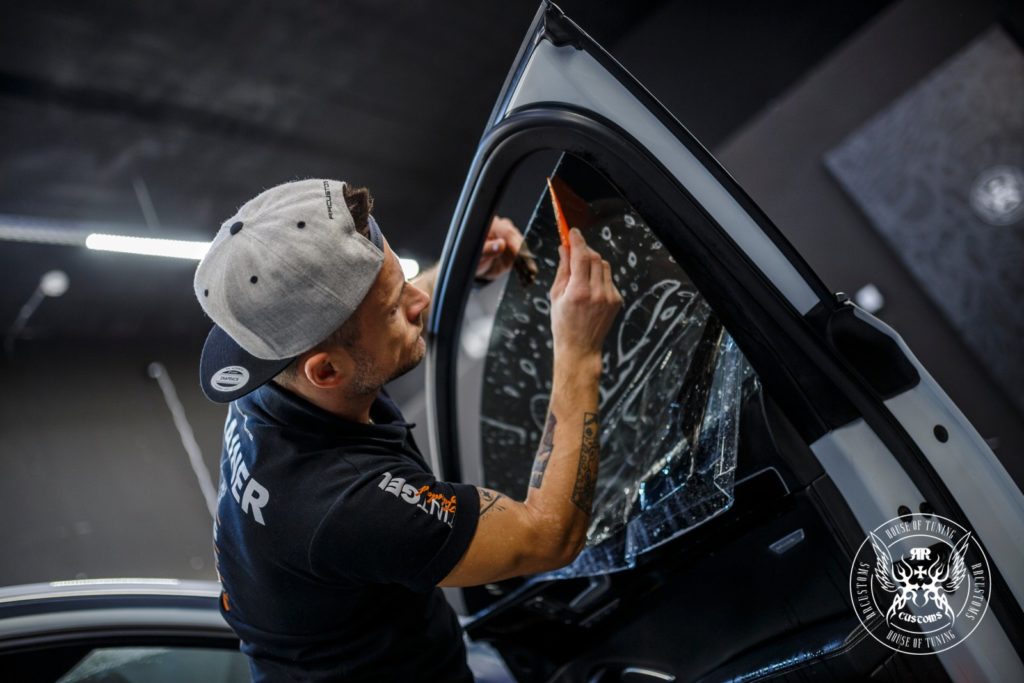How Car Glass Tinting Helps Reduce Driver Fatigue and Improve Road Safety
Wiki Article
A Comprehensive Guide to Recognizing Vehicle Home Window Color and Its Advantages
Car window tinting serves greater than simply an aesthetic objective for vehicles. It uses different types, each with unique functions and advantages. Understanding these choices, together with legal guidelines and upkeep suggestions, is vital for any type of car owner. The benefits might substantially boost driving comfort and automobile longevity. As one explores the nuances of home window tinting, the inquiry emerges: what kind of tint is best suited for individual requirements?Comprehending Vehicle Window Tint: What It Is and How It Works
Vehicle home window color functions as a protective obstacle that boosts automobile aesthetics while offering practical advantages. This slim movie is put on the indoor surface area of car home windows, reducing glow and obstructing hazardous ultraviolet (UV) rays from the sun. By filtering sunlight, automobile window color assists to control the indoor temperature level of the automobile, causing boosted convenience for travelers and lowered reliance on air conditioning.Additionally, it shields the automobile's interior from fading, preserving both furniture and dashboard products. The tint can also improve privacy, making it extra challenging for outsiders to see inside the lorry. In addition, specific kinds of home window tint can boost safety and security; in case of a crash, the movie assists hold destroyed glass together, lowering the danger of injury from flying shards. Generally, vehicle window color serves both practical and aesthetic objectives, making it a popular option among automobile owners.Types of Window Tint: A Review of Options
When taking into consideration home window tint options, numerous types are readily available, each with distinctive qualities. Colored, metalized, and ceramic home window tints supply differing degrees of heat denial, UV protection, and aesthetic charm. Comprehending these differences can assist car proprietors make educated choices based upon their demands and choices.Colored Window Tint
Colored window tint represents a popular option amongst auto proprietors looking for a budget-friendly and efficient way to enhance their car's aesthetic appeals and personal privacy. This kind of color is produced by placing a layer of color in between a protective finishing and an adhesive layer, causing a dark look that reduces glare and improves aesthetic convenience. While dyed home window color efficiently blocks dangerous UV rays, it may not provide the exact same degree of warmth rejection as various other tint kinds. Furthermore, its shade can fade in time, potentially diminishing its efficiency. In spite of these disadvantages, colored window tint stays preferred for its cost-effectiveness and capability to supply a sleek, trendy want to various vehicle models.Metalized Home Window Tint
Metalized window tint uses an equilibrium of style and functionality, making it a preferred option amongst car proprietors. This sort of tint integrates metallic fragments within the movie, enhancing both visual appeal and warm denial. The reflective high quality of metalized color helps to decrease glow and boost personal privacy, while also providing UV protection, which safeguards the lorry's interior. Additionally, metalized home window color can strengthen window toughness, potentially protecting against ruining during crashes. However, it is necessary to keep in mind that the metallic parts can disrupt electronic signals, such as general practitioner and cellular phone function. Generally, metalized home window color gives an effective solution for those looking for a combination of resilience, sunlight, and appearance defense for their cars.Ceramic Home Window Color
Ceramic window tint represents a sophisticated alternative in the spectrum of automotive window movies, supplying distinctive advantages over standard colors. Unlike dyed or metalized movies, ceramic colors make use of advanced ceramic bits, which effectively turn down heat and UV rays without compromising presence. This innovation ensures that automobiles stay cooler, reducing dependence on air conditioning and improving fuel effectiveness. Furthermore, ceramic home window tints are less likely to interfere with electronic tools, such as GPS or mobile signals, making them a sensible choice for modern lorries. Their resilience and scrape resistance contribute to a much longer lifespan contrasted to other types of tints. Overall, ceramic window color gives remarkable efficiency, comfort, and defense, making it a preferred option for critical vehicle proprietors.Advantages of Auto Window Tint: Beyond Appearances
While numerous individuals associate vehicle window color with improved style, its benefits extend much past mere visual appeals. One considerable benefit is warm reduction; window tint can obstruct as much as 99% of hazardous UV rays, safeguarding and maintaining the indoor cooler upholstery from fading. This not only enhances comfort during hot weather condition but likewise lowers reliance on cooling, resulting in boosted fuel efficiency.In enhancement, automobile window tint supplies an included layer of personal privacy and safety. Colored home windows make it hard for outsiders to see inside the lorry, which can prevent theft and safeguard belongings. Furthermore, numerous colors strengthen the glass, lowering the possibility of ruining in case of a mishap, thus improving safety.In enhancement to these functional benefits, automobile window tint can also add to glare decrease, improving presence for passengers and drivers alike. This multifaceted strategy to convenience and security makes window tint an important investment for vehicle proprietors.Legal Factors To Consider: Tinting Rules by State
Prior to committing to vehicle home window tint, automobile proprietors must navigate a complicated landscape of tinting guidelines that differ by state. Each state has certain regulations controling the permitted degrees of tint darkness and reflectivity for various home windows, including windscreens, front side home windows, and rear home windows. These regulations often consist of noticeable light transmission (VLT) portions, which determine how much light can travel through the colored glass.Some states permit darker colors on rear home windows while restricting front side and windscreen tints for safety and security reasons. In addition, specific states might need a certification from the supplier to validate conformity with tinting laws. Breaking these guidelines can result in fines, necessary elimination of the color, or both. Subsequently, it is necessary for automobile owners to research their state's regulations thoroughly to assure legal click this compliance before setting up home window tint. This persistance can save money and time in the future.Picking the Right Color: Aspects to Take into consideration
When selecting the proper home window tint for an automobile, a number of essential elements come into play. Tint darkness levels, UV defense rankings, and compliance with legal regulations are necessary factors to consider to ensure both visual appeals and capability - Car Glass Tinting. Assessing these facets will certainly help individuals make an educated decision that meets their needs and complies with neighborhood lawsColor Darkness Degrees
Selecting the appropriate tint darkness level is crucial for accomplishing the preferred equilibrium between aesthetics and functionality in auto home window tinting. Various states have varying legal policies concerning tint darkness, which can impact the option. Generally, tints are measured in percents, with reduced percents showing darker tones. Darker tints provide enhanced privacy and a smooth appearance yet can lower visibility, particularly at evening. On the other hand, lighter colors keep a more open feel, making certain sufficient presence while still offering some warm and glow decrease. When making a choice, individuals must consider their driving routines, neighborhood legislations, and individual preferences. Ultimately, the appropriate tint darkness degree improves the lorry's appearance while making certain safety and security and compliance with legal criteria.UV Security Score
Tint darkness levels play a considerable duty in the general effectiveness of automobile home window tinting, however an additional vital aspect to evaluate is the UV security ranking of the chosen color. This score indicates the percentage of damaging ultraviolet rays that the tint can block. High-quality colors usually give 99% or even more UV defense, safeguarding guests and the automobile's interior from sunlight damages. Extended exposure to UV rays can lead to skin troubles and fading of furniture, making a high UV protection rating necessary for health and durability. When choosing window color, consumers ought to prioritize this score alongside darkness levels to guarantee optimum convenience and safety while driving. Recognizing these factors aids in making a notified decision when purchasing auto window tinting.Lawful Rules Conformity
Recognizing neighborhood lawful regulations is important for anyone thinking about auto window tinting. Each state or area has details regulations governing the allowable levels of tint darkness and reflectivity for different home windows. These regulations frequently define the noticeable light transmission portion, figuring out just how much light can pass with the tinted glass. Non-compliance can result in penalties, compulsory elimination of the tint, or issues throughout lorry assessments. In addition, some locations may have restrictions on making use of specific tinting products, needing customers to pick items that satisfy security criteria. It is crucial for automobile owners to investigate their regional laws completely before picking window color to ensure conformity and prevent potential lawful difficulties.Installation Refine: do it yourself vs. Specialist Services
Just how does one choose in between a DIY installment website link and working with specialist solutions for car window tinting? The option often rests on budget plan, experience, and wanted outcomes. A do it yourself strategy can be cost-effective, check this site out permitting people to conserve on labor costs. It requires a certain level of ability and knowledge concerning the tinting procedure. Those who are precise and individual may locate success with DIY sets offered in the market.Conversely, professional services provide know-how and high-grade materials, making certain a perfect coating. Specialists frequently guarantee their job, giving comfort versus possible issues such as gurgling or peeling off. In addition, they are familiar with local regulations relating to tinting, which can be complicated for the typical cars and truck owner.Ultimately, the choice mirrors an equilibrium between cost, individual capacity, and the expected quality of the tinting work. Each choice has its benefits, and the finest selection depends upon individual conditions and choices.
Upkeep Tips: Maintaining Your Color in Top Problem
Maintaining the appearance and functionality of window color requires normal interest and care, especially in differing climate problems. To protect the color, it is vital to avoid using unpleasant cleansing materials, which can damage the film or scrape. Car Glass Tinting. Rather, soft microfiber cloths and gentle, ammonia-free cleaners need to be utilized for cleaning up the tinted surfaces.Furthermore, it is advisable to wait at the very least thirty days after installation prior to cleansing the home windows to allow the color to completely stick. Car park in shaded areas or utilizing sunshades can help in reducing the fading results of UV rays and prolong the color's life expectancy. Normal assessments for bubbles, peeling, or staining are advised, as early discovery can assist in repair work. Preventing severe temperature variations, such as pushing warm home windows in chilly weather, will certainly help maintain the tint's integrity and appearance over time.Frequently Asked Inquiries

For How Long Does Window Tint Generally Last on a Lorry?
Home window color typically lasts between five to 10 years, depending upon aspects such as top quality, application, and environmental conditions. Regular maintenance and proper treatment can extend its life-span, ensuring ideal efficiency and appearance gradually.Can Home Window Tinting Damage My Auto's Original Glass?
Window tinting, when applied correctly, does not damage an auto's original glass. Incorrect setup or low-quality products may lead to problems like bubbling or peeling off, possibly affecting the glass's stability over time.Is Window Tinting Safe for All Kinds of Vehicles?

Will Home Window Tinting Space My Automobile Service Warranty?
The question of whether home window tinting spaces a car guarantee commonly relies on the maker's policies. Usually, if the tint does not harm the car, warranties commonly stay intact. However, consulting the dealership is a good idea.
Can I Eliminate Window Tint Myself if Needed?
Eliminating home window tint oneself is feasible, but it calls for careful interest to avoid harming the glass. People need to make use of suitable tools and strategies to assure an effective removal without leaving adhesive deposit or scratches behind. While colored window color properly blocks harmful UV rays, it might not provide the same level of warmth rejection as other color types. Ceramic home window tint represents an innovative option in the range of vehicle home window films, providing distinct advantages over standard colors. Before dedicating to automobile home window tint, car owners have to navigate an intricate landscape of tinting laws that differ by state. These laws often include visible light transmission (VLT) percentages, which dictate how much light can pass with the colored glass.Some states allow darker colors on back home windows while restricting front side and windshield colors for safety and security factors. Tint darkness degrees play a substantial role in the general efficiency of vehicle home window tinting, yet another crucial aspect to review is the UV protection rating of the picked tint.Report this wiki page